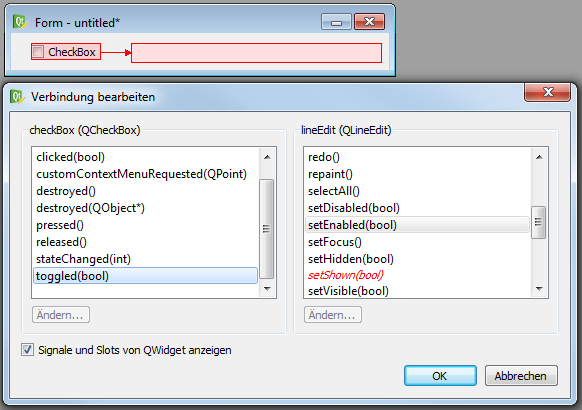Qt5 Signal Slot Connection
Posted By admin On 02/08/22Hi,
- Qt5 Signal Slot Connection Switch
- Qt5 Signal Slot Connection Booster
- Qt5 Signal Slot Connection Speed Test
- Qt5 Signal Slot Connection Adapters
- Qt5 Signal Slot Connection Tool
- Qt5 Signal Slot Connection Device
I want to connect some signals to some slots in an application of mine. In this very situation, this does NOT work when the connection is established in the constructor, but is DOES work when it is done somewhere later in the program logic (e.g. in a slot called after a button click).
I explain the situation with some example code:
I have a dll that declares a Qt plugin (class MyObject) that inherits from MySignalInterface.
MyObject owns MySubObject, that inherits from MySlotInterface.
Compiling/building/loading the plugin all works fine. When I now want to connect the mySignal from MyObject to mySlot from MySubObject in the constructor of MyObject, the slot is not called when the signal is emitted (I checked that the signal is emitted by setting a breakpoint in the respective moc_MyObject.cpp). When I connect somewhere later (within onButtonPress()), the connection works. There is no output on the command line regarding failed signal/slot connections, and the result value from the call to connect() in the constructor is true.
I don't know how to investigate what is going wrong here with the connections. How to debug this?
Below, some code fragments for clarification. Any help would be appreciated.
I am working on Windows10 with Visual Studio 2015 and Qt 5.10.0.
MyObject.cpp
MyObject.h
MySignalInterface.h
My Problem is that the SIGNAL comes from the Dialog with the name onpushButtonEnterclicked and my SLOT is inside my mainwindow with the name setCurrentIndex. I,ve read the post's: 'How to Connect Signal from MainWindow to Slot in Dialog' and 'Qt connect mainwindow and dialog using signal and slot'. From Qt 5.0 onwards, Qt offers two different ways to write signal-slot connections in C: The string-based connection syntax and the functor-based connection syntax. There are pros and cons to both syntaxes. The table below summarizes their differences. From Qt 5.0 onwards, Qt offers two different ways to write signal-slot connections in C: The string-based connection syntax and the functor-based connection syntax. There are pros and cons to both syntaxes. The table below summarizes their differences. Qt connect lambda. New Signal Slot Syntax, Qt connection system is smart enough to delete connections if either the sender or the receiver is deleted, so in our first version of setMonitor, if This relates to the new lambda syntax supported in Qt 5, and if your compiler supports it.
MySubObject.h

MySlotInterface.h
One key and distinctive feature of Qt framework is the use of signals and slots to connect widgets and related actions. But as powerful the feature is, it may look compelling to a lot of developers not used to such a model, and it may take some time at the beginning to get used to understand how to use signals and slots properly. However, since version 4.4, we can relay on auto-connections to simplify using this feature.Back in the old days, signals and slots connections were set up for compile time (or even run time) manually, where developers used the following sentence:
this is, we stated the sender object's name, the signal we want to connect, the receiver object's name and the slot to connect the signal to.
Now there's an automatic way to connect signals and slots by means of QMetaObject's ability to make connections between signals and suitably-named slots. And that's the key: if we use an appropriate naming convention, signals and slots will be properly connected without the need to write additional code for that to happen. So by declaring and implementing a slot with a name that follows the following convention:
uic (the User Interface Compiler of Qt) will automatically generate code in the dialog's
Qt5 Signal Slot Connection Switch
setupUi() function to connect button's signal with dialog's slot.Qt5 Signal Slot Connection Booster
So back to our example, the class implementing the slot must define it like this:
Qt5 Signal Slot Connection Speed Test
Qt5 Signal Slot Connection Adapters
We then write the method's implementatio to carry on an action when the signal is emitted: